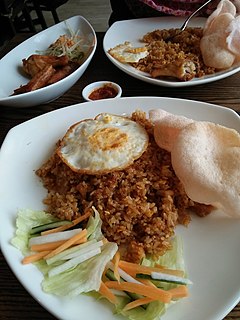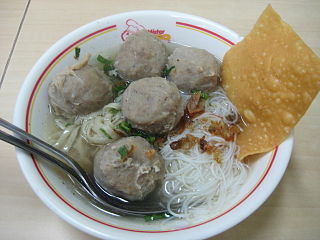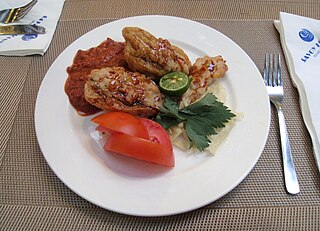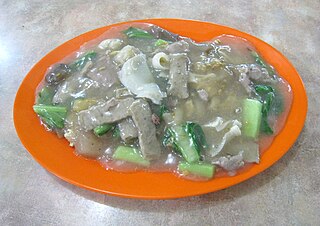
Chinese Indonesian cuisine is characterized by the mixture of Chinese with local Indonesian style. Chinese Indonesians brought their legacy of Chinese cuisine, and modified some of the dishes with the addition of Indonesian ingredients, such as kecap manis, palm sugar, peanut sauce, chili, santan and local spices to form a hybrid Chinese-Indonesian cuisine. Some of the dishes and cakes share the same style as in Malaysia and Singapore which are known as the Nonya cuisine by the Peranakan.

Nasi goreng, literally meaning "fried rice" in both the Indonesian and Malay languages, is an Indonesian rice dish with pieces of meat and vegetables added. It can refer simply to fried pre-cooked rice, a meal including stir fried rice in a small amount of cooking oil or margarine, typically spiced with kecap manis, shallot, garlic, ground shrimp paste, tamarind and chilli and accompanied by other ingredients, particularly egg, chicken and prawns. There is also another kind of nasi goreng which is made with ikan asin which is also popular across Indonesia. Nasi goreng is sometimes described as Indonesian stir-fried rice, although it is also popular in Southeast Asia. Beyond the Malay Archipelago, it has gained popularity through Indonesian influence in Sri Lanka and via Indonesian immigrant communities in Suriname and the Netherlands. It is distinguished from other Asian fried rice recipes by its aromatic, earthy and smoky flavor, owed to generous amount of caramelised sweet soy sauce and powdered shrimp paste, and the taste is stronger and spicier compared to Chinese fried rice.

Fried noodles are common throughout East Asia, Southeast Asia and South Asia. Many varieties, cooking styles, and ingredients exist.

Mie kuah, literally "noodle soup", or also known as mie rebus/mi rebus or mee rebus, literally "boiled noodles", is a noodle soup dish from Indonesia, and popular in Malaysia, and Singapore.

Bakmi consists of two Hokkien Chinese words literally translated to English as "meat noodles". Bakmi is a wheat based noodle which was brought to Indonesian archipelago by Hokkien Chinese immigrants from Fujian, generally prepared and topped with minced pork seasoned in soy sauce and A few slices of char siu (叉燒) or barbecued pork, with addition of Chinese green vegetables and a bowl of broth.

Mie goreng, also known as bakmi goreng, is an often spicy fried noodle dish, originating from Indonesia, common in Malaysia, Brunei Darussalam, and Singapore. It is made with thin yellow noodles stir fried in cooking oil with garlic, onion or shallots, fried prawn, chicken, beef, or sliced bakso (meatballs), chili, Chinese cabbage, cabbages, tomatoes, egg, and other vegetables. Ubiquitous in Indonesia, it is sold by food vendors from street-hawkers, warungs, to high-end restaurants. It is an Indonesian one-dish meal favourite, although street food hawkers commonly sell it together with nasi goreng. It is commonly available at Mamak stalls in Singapore, Brunei, and Malaysia and is often spicy. In Sri Lanka, mee goreng is a popular dish due to Malay cultural influences and is sold at street food stalls around the country.

Indomie is a brand of instant noodle produced by Indonesian company PT Indofood CBP Sukses Makmur Tbk, better known as Indofood. It is distributed in Australia, Asia, Africa, New Zealand, United States, Canada, Europe and Middle Eastern countries. Outside its main manufacturing plants in Indonesia, Indomie is also produced in Nigeria since 1995 where it is a popular brand and has the largest instant noodle manufacturing plant in Africa.

Bakso or baso is an Indonesian meatball, or a meat paste made from beef surimi. Its texture is similar to the Chinese beef ball, fish ball, or pork ball. The word bakso may refer to a single meatball or the complete dish of meatball soup. Mie bakso refers to bakso served with yellow noodles and rice vermicelli, while bakso kuah refers to bakso soup served without noodles.

Javanese cuisine is the cuisine of Javanese people, a major ethnic group in Indonesia, more precisely the province of Central Java, Yogyakarta and East Java. Though the cuisine of Sumatra is known for its spiciness with notable Indian and Arabic influences, Javanese cuisine is more indigenously developed and noted for its simplicity. Some of Javanese dishes demonstrate foreign influences, most notably Chinese.

Batagor is a Sundanese dish from Indonesia, and popular in Southeast Asia, consisting of fried fish dumplings, usually served with peanut sauce. It is traditionally made from minced tenggiri (wahoo) fish meat, although other types of seafood such as tuna, mackerel, and prawn may also be used. The fish paste is subsequently stuffed into wonton skins or filled into tofu, and then deep fried in palm oil.

Soto mie, Soto mi, or Mee soto is a spicy Indonesian noodle soup dish commonly found in Indonesia, Malaysia, and Singapore. Mie means noodle made of flour, salt and egg, while soto refers to Indonesian soup. In Indonesia it is called soto mie and is considered as one variant of soto, while in Malaysia and Singapore it is called mee soto.

Kwetiau goreng is a Chinese Indonesian stir fried flat rice noodle dish from Indonesia and popular in Southeast Asia. This flavorful and spicy fried noodle dish is common in Indonesia. It is made from noodles, locally known as kwetiau, which are stir fried in cooking oil with garlic, onion or shallots, beef, chicken, fried prawn, crab or sliced bakso (meatballs), chili, Chinese cabbage, cabbages, tomatoes, egg, and other vegetables with an ample amount of kecap manis. In Asia, kwetiau is available in two forms, dried and fresh. Its recipe is quite similar to another Chinese Indonesian favourite, mie goreng, with the exception of replacing yellow wheat noodles for flat rice noodles.

Mie ayam, mi ayam or bakmi ayam is a common Indonesian dish of seasoned yellow wheat noodles topped with diced chicken meat (ayam). It especially common in Indonesia, Singapore and Malaysia, and can trace its origin to Chinese cuisine. In Indonesia, the dish is recognized as a popular Chinese Indonesian dish, served from simple travelling vendor carts frequenting residential areas, humble street-side warung to restaurants.

Mie koclok, is an Indonesian chicken noodle soup, a specialty of Cirebon city, West Java. The noodles come with a white-colored extra-thick porridge-like soup, made of chicken broth and coconut milk soup, which is coagulated with corn starch or tapioca. Other ingredients include shredded chicken breast, cabbage, bean sprouts, hard boiled egg, kaffir lime juice, and sprinkled with sliced fresh celery, spring onion, and fried shallot.

Mie kangkung, is an Indonesian vegetable noodle soup with kangkung, usually served with bakso meatball and mushroom. It is of a specialty of Betawi cuisine, Jakarta, Indonesia. The yellow egg noodles come with a brown-colored thick soup, made of chicken or beef broth, which is thickened with tapioca, spiced and mixed with garlic and kecap manis. Other ingredients include bakso meatballs, bean sprouts, mushroom, hard boiled quail eggs and sprinkled with bawang goreng and added with dash of kaffir lime juice and sambal.

Char kway teow is a popular noodle dish from Maritime Southeast Asia, notably in Indonesia, Malaysia, Singapore, and Brunei. In Hokkien, Char means “stir-fried” and kway teow refers to flat rice noodles. The dish is considered a national favourite in Malaysia and Singapore.

Soto is a traditional Indonesian soup mainly composed of broth, meat, and vegetables. Many traditional soups are called soto, whereas foreign and Western influenced soups are called sop.

Beef kway teow or beef kwetiau and kwetiau sapi is an Chinese Indonesian dish of flat rice noodles stir-fried and topped with slices of beef or sometimes beef offal, served either dry or with soup. The dish is commonly found in Southeast Asian countries, especially Indonesia, Singapore and Malaysia, and can trace its origin to Chinese tradition.


















